headrest KIA RIO 2020 Owners Manual
[x] Cancel search | Manufacturer: KIA, Model Year: 2020, Model line: RIO, Model: KIA RIO 2020Pages: 516, PDF Size: 10.49 MB
Page 18 of 516
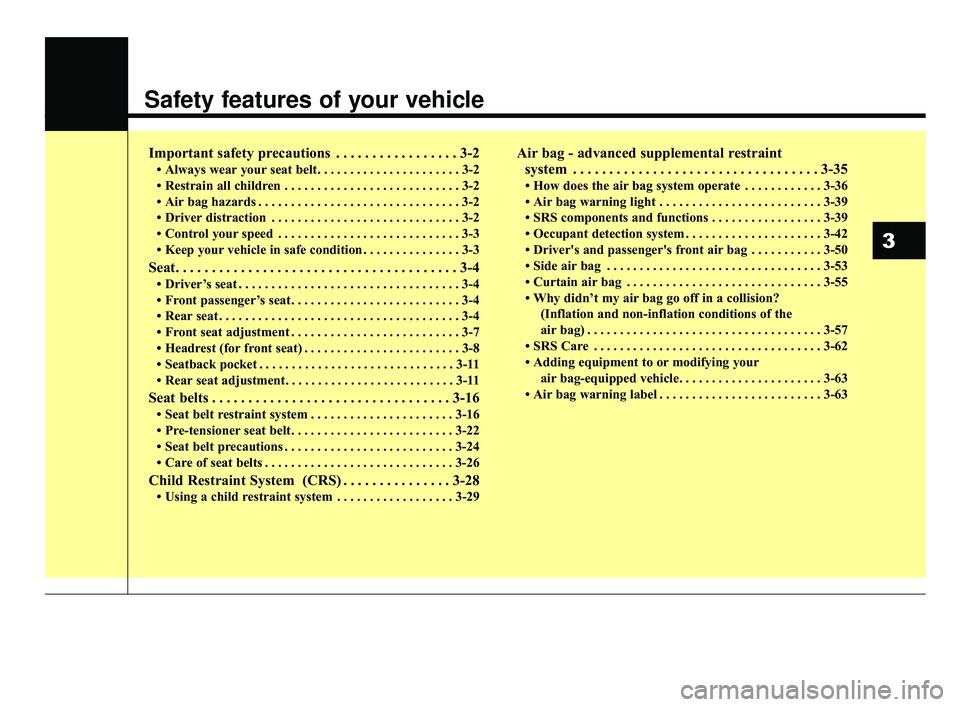
Safety features of your vehicle
Important safety precautions . . . . . . . . . . . . . . . . . 3-2
• Always wear your seat belt. . . . . . . . . . . . . . . . . . . . . . 3-2
• Restrain all children . . . . . . . . . . . . . . . . . . . . . . . . . . . 3-2
• Air bag hazards . . . . . . . . . . . . . . . . . . . . . . . . . . . . . . . 3-2
• Driver distraction . . . . . . . . . . . . . . . . . . . . . . . . . . . . . 3-2
• Control your speed . . . . . . . . . . . . . . . . . . . . . . . . . . . . 3-3
• Keep your vehicle in safe condition . . . . . . . . . . . . . . . 3-3
Seat. . . . . . . . . . . . . . . . . . . . . . . . . . . . . . . . . . . . \
. . . 3-4
• Driver’s seat . . . . . . . . . . . . . . . . . . . . . . . . . . . . . . . . . . 3-4
• Front passenger’s seat. . . . . . . . . . . . . . . . . . . . . . . . . . 3-4
• Rear seat . . . . . . . . . . . . . . . . . . . . . . . . . . . . . . . . . . . . \
. 3-4
• Front seat adjustment . . . . . . . . . . . . . . . . . . . . . . . . . . 3-7
• Headrest (for front seat) . . . . . . . . . . . . . . . . . . . . . . . . 3-8
• Seatback pocket . . . . . . . . . . . . . . . . . . . . . . . . . . . . . . 3-11
• Rear seat adjustment. . . . . . . . . . . . . . . . . . . . . . . . . . 3-11
Seat belts . . . . . . . . . . . . . . . . . . . . . . . . . . . . . . . . . 3-16
• Seat belt restraint system . . . . . . . . . . . . . . . . . . . . . . 3-16
• Pre-tensioner seat belt. . . . . . . . . . . . . . . . . . . . . . . . . 3-22
• Seat belt precautions . . . . . . . . . . . . . . . . . . . . . . . . . . 3-24
• Care of seat belts . . . . . . . . . . . . . . . . . . . . . . . . . . . . . 3-26
Child Restraint System (CRS) . . . . . . . . . . . . . . . 3-28
• Using a child restraint system . . . . . . . . . . . . . . . . . . 3-29
Air bag - advanced supplemental restraint system . . . . . . . . . . . . . . . . . . . . . . . . . . . . . . . . . . 3-35\
• How does the air bag system operate . . . . . . . . . . . . 3-36
• Air bag warning light . . . . . . . . . . . . . . . . . . . . . . . . . 3-39
• SRS components and functions . . . . . . . . . . . . . . . . . 3-39
• Occupant detection system . . . . . . . . . . . . . . . . . . . . . 3-42
• Driver's and passenger's front air bag . . . . . . . . . . . 3-50
• Side air bag . . . . . . . . . . . . . . . . . . . . . . . . . . . . . . . . . 3-53
• Curtain air bag . . . . . . . . . . . . . . . . . . . . . . . . . . . . . . 3-55
• Why didn’t my air bag go off in a collision?
(Inflation and non-inflation conditions of the
air bag) . . . . . . . . . . . . . . . . . . . . . . . . . . . . . . . . . . . . \
3-57
• SRS Care . . . . . . . . . . . . . . . . . . . . . . . . . . . . . . . . . . . 3-\
62
• Adding equipment to or modifying your air bag-equipped vehicle. . . . . . . . . . . . . . . . . . . . . . 3-63
• Air bag warning label . . . . . . . . . . . . . . . . . . . . . . . . . 3-63
3
SC CAN (ENG) 3.QXP 6/7/2019 9:37 AM Page 1
Page 21 of 516
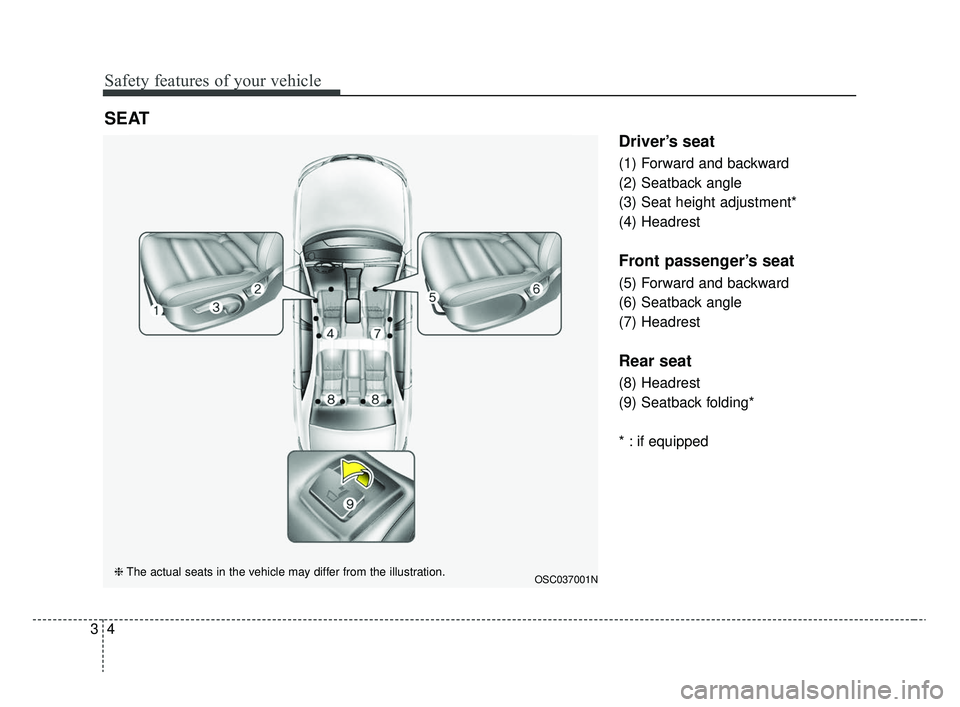
Safety features of your vehicle
43
Driver’s seat
(1) Forward and backward
(2) Seatback angle
(3) Seat height adjustment*
(4) Headrest
Front passenger’s seat
(5) Forward and backward
(6) Seatback angle
(7) Headrest
Rear seat
(8) Headrest
(9) Seatback folding*
* : if equipped
SEAT
OSC037001N❈The actual seats in the vehicle may differ from the illustration.
SC CAN (ENG) 3.QXP 6/7/2019 9:37 AM Page 4
Page 25 of 516
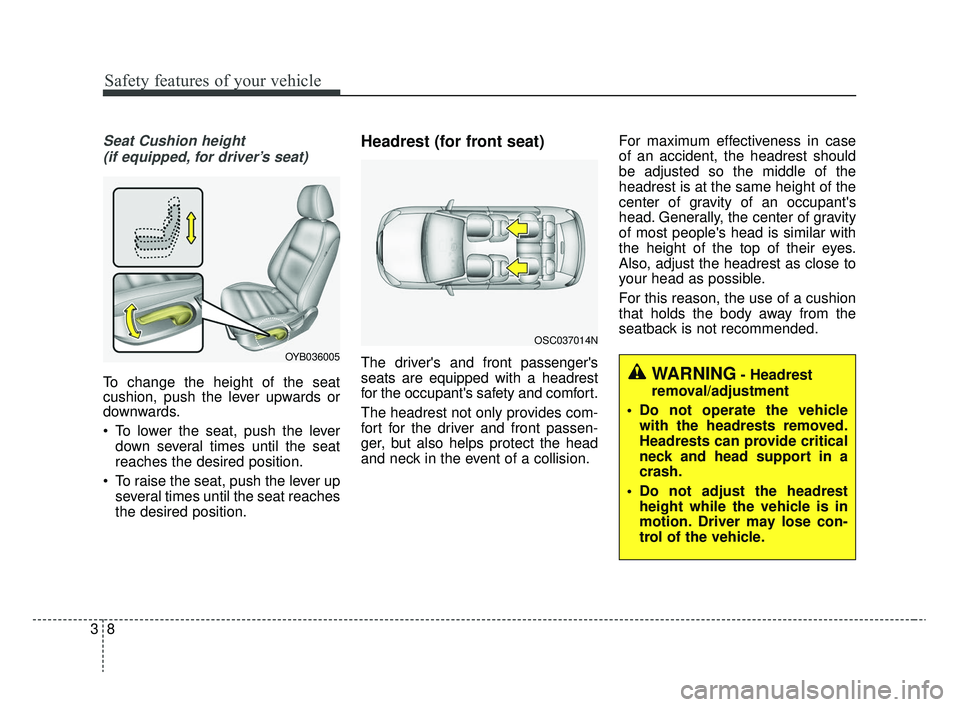
Safety features of your vehicle
83
Seat Cushion height (if equipped, for driver’s seat)
To change the height of the seat
cushion, push the lever upwards or
downwards.
To lower the seat, push the lever down several times until the seat
reaches the desired position.
To raise the seat, push the lever up several times until the seat reaches
the desired position.
Headrest (for front seat)
The driver's and front passenger's
seats are equipped with a headrest
for the occupant's safety and comfort.
The headrest not only provides com-
fort for the driver and front passen-
ger, but also helps protect the head
and neck in the event of a collision. For maximum effectiveness in case
of an accident, the headrest should
be adjusted so the middle of the
headrest is at the same height of the
center of gravity of an occupant's
head. Generally, the center of gravity
of most people's head is similar with
the height of the top of their eyes.
Also, adjust the headrest as close to
your head as possible.
For this reason, the use of a cushion
that holds the body away from the
seatback is not recommended.OYB036005
WARNING- Headrest
removal/adjustment
Do not operate the vehicle with the headrests removed.
Headrests can provide critical
neck and head support in a
crash.
Do not adjust the headrest height while the vehicle is in
motion. Driver may lose con-
trol of the vehicle.
OSC037014N
SC CAN (ENG) 3.QXP 6/7/2019 9:37 AM Page 8
Page 26 of 516
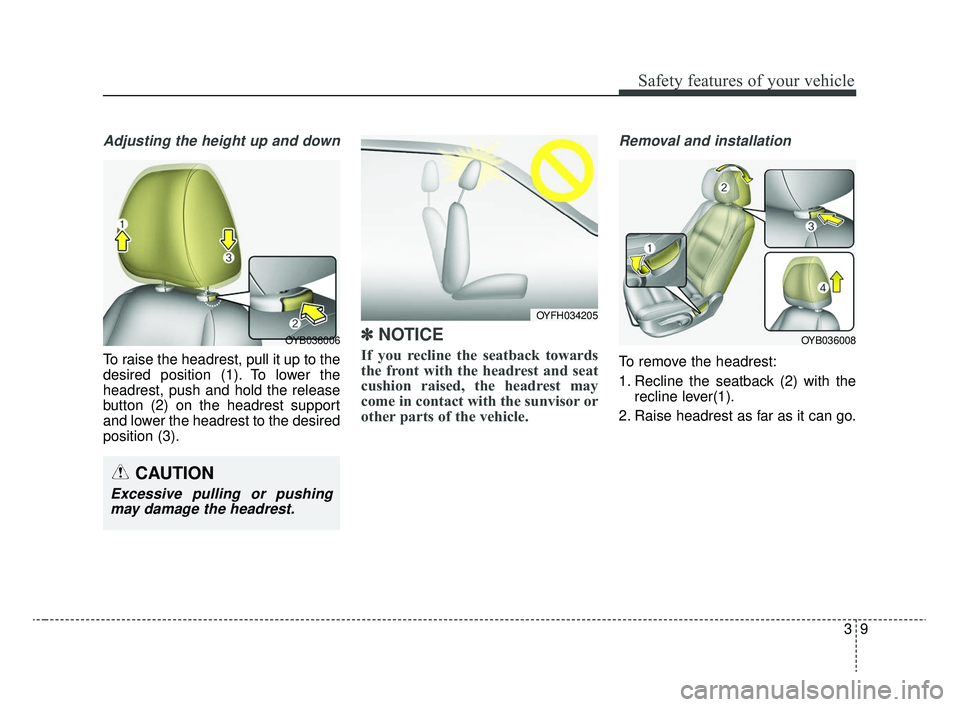
39
Safety features of your vehicle
Adjusting the height up and down
To raise the headrest, pull it up to the
desired position (1). To lower the
headrest, push and hold the release
button (2) on the headrest support
and lower the headrest to the desired
position (3).
✽ ✽NOTICE
If you recline the seatback towards
the front with the headrest and seat
cushion raised, the headrest may
come in contact with the sunvisor or
other parts of the vehicle.
Removal and installation
To remove the headrest:
1. Recline the seatback (2) with the
recline lever(1).
2. Raise headrest as far as it can go.
OYB036006
CAUTION
Excessive pulling or pushing may damage the headrest.
OYFH034205
OYB036008
SC CAN (ENG) 3.QXP 6/7/2019 9:37 AM Page 9
Page 27 of 516
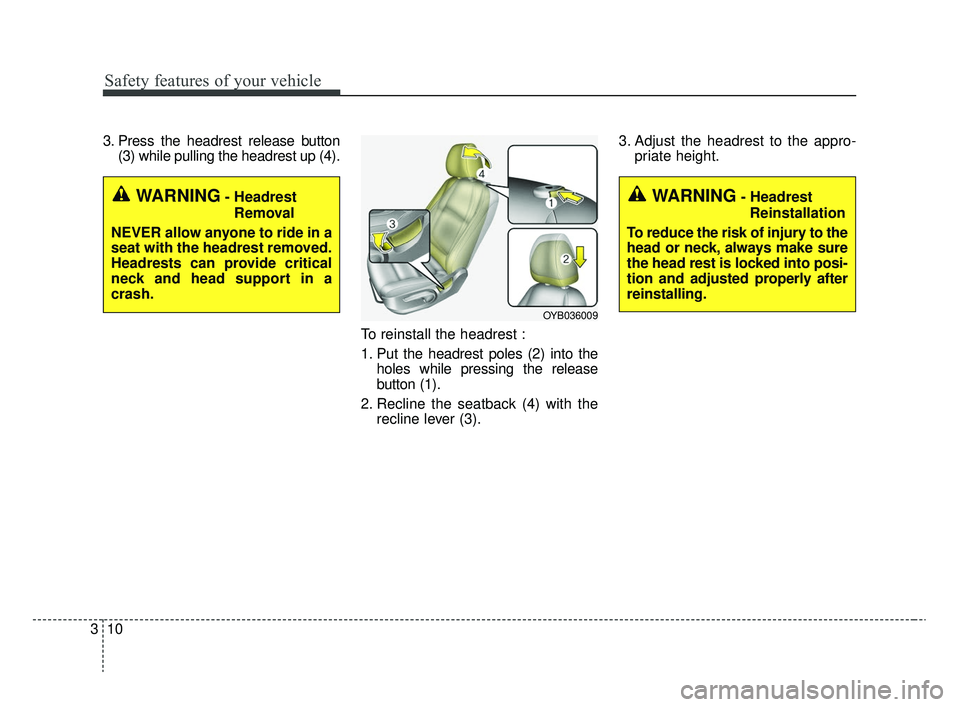
Safety features of your vehicle
10
3
3. Press the headrest release button
(3) while pulling the headrest up (4).
To reinstall the headrest :
1. Put the headrest poles (2) into theholes while pressing the release
button (1).
2. Recline the seatback (4) with the recline lever (3). 3. Adjust the headrest to the appro-
priate height.
WARNING- Headrest
Removal
NEVER allow anyone to ride in a
seat with the headrest removed.
Headrests can provide critical
neck and head support in a
crash.
OYB036009
WARNING- Headrest Reinstallation
To reduce the risk of injury to the
head or neck, always make sure
the head rest is locked into posi-
tion and adjusted properly after
reinstalling.
SC CAN (ENG) 3.QXP 6/7/2019 9:37 AM Page 10
Page 28 of 516
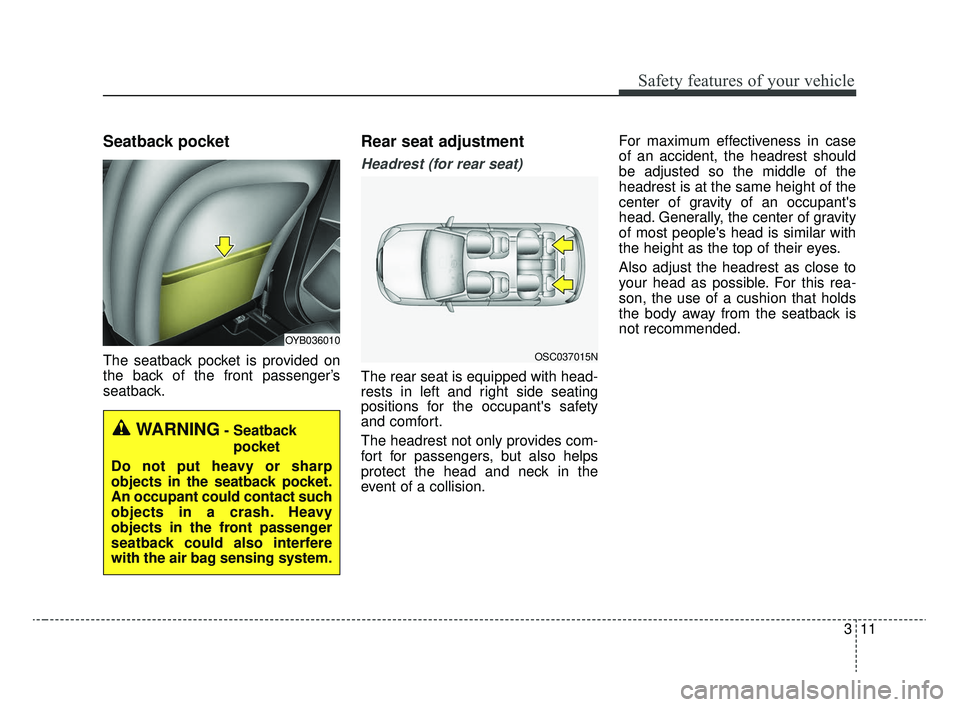
311
Safety features of your vehicle
Seatback pocket
The seatback pocket is provided on
the back of the front passenger’s
seatback.
Rear seat adjustment
Headrest (for rear seat)
The rear seat is equipped with head-
rests in left and right side seating
positions for the occupant's safety
and comfort.
The headrest not only provides com-
fort for passengers, but also helps
protect the head and neck in the
event of a collision.For maximum effectiveness in case
of an accident, the headrest should
be adjusted so the middle of the
headrest is at the same height of the
center of gravity of an occupant's
head. Generally, the center of gravity
of most people's head is similar with
the height as the top of their eyes.
Also adjust the headrest as close to
your head as possible. For this rea-
son, the use of a cushion that holds
the body away from the seatback is
not recommended.
WARNING- Seatback
pocket
Do not put heavy or sharp
objects in the seatback pocket.
An occupant could contact such
objects in a crash. Heavy
objects in the front passenger
seatback could also interfere
with the air bag sensing system.
OYB036010
OSC037015N
SC CAN (ENG) 3.QXP 6/7/2019 9:38 AM Page 11
Page 29 of 516
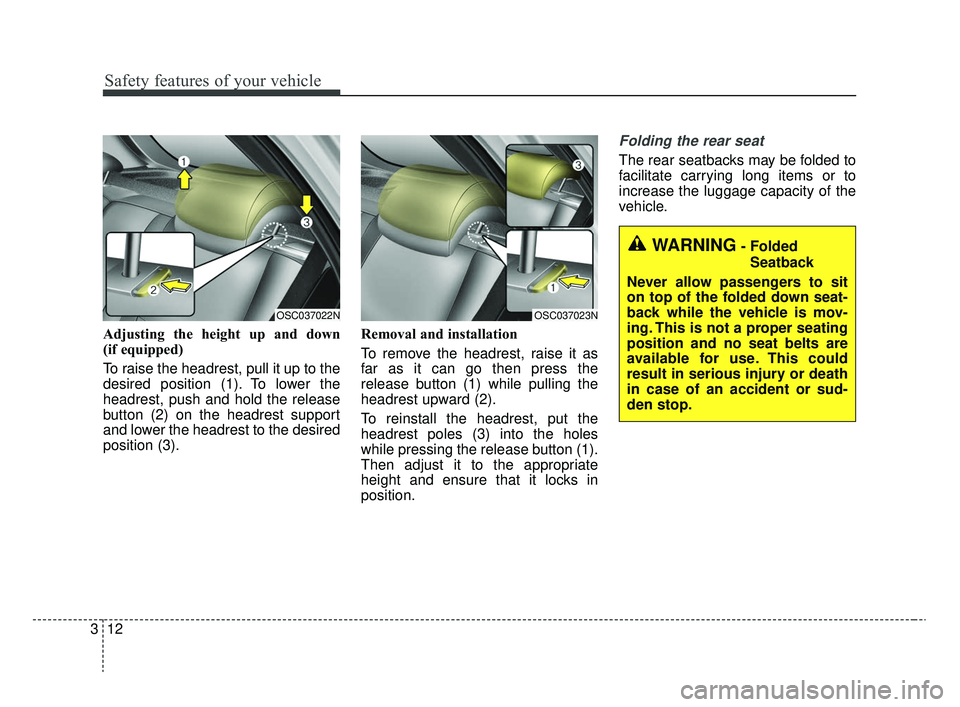
Safety features of your vehicle
12
3
Adjusting the height up and down
(if equipped)
To raise the headrest, pull it up to the
desired position (1). To lower the
headrest, push and hold the release
button (2) on the headrest support
and lower the headrest to the desired
position (3). Removal and installation
To remove the headrest, raise it as
far as it can go then press the
release button (1) while pulling the
headrest upward (2).
To reinstall the headrest, put the
headrest poles (3) into the holes
while pressing the release button (1).
Then adjust it to the appropriate
height and ensure that it locks in
position.
Folding the rear seat
The rear seatbacks may be folded to
facilitate carrying long items or to
increase the luggage capacity of the
vehicle.
OSC037022NOSC037023N
WARNING- Folded
Seatback
Never allow passengers to sit
on top of the folded down seat-
back while the vehicle is mov-
ing. This is not a proper seating
position and no seat belts are
available for use. This could
result in serious injury or death
in case of an accident or sud-
den stop.
SC CAN (ENG) 3.QXP 6/7/2019 9:38 AM Page 12
Page 30 of 516
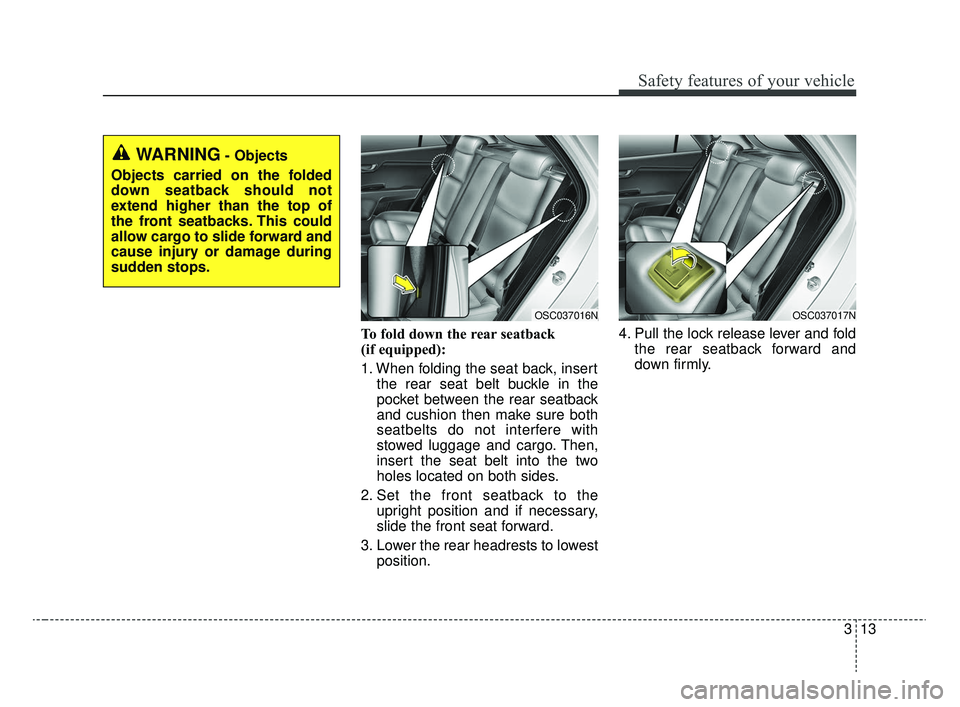
313
Safety features of your vehicle
To fold down the rear seatback
(if equipped):
1. When folding the seat back, insertthe rear seat belt buckle in the
pocket between the rear seatback
and cushion then make sure both
seatbelts do not interfere with
stowed luggage and cargo. Then,
insert the seat belt into the two
holes located on both sides.
2. Set the front seatback to the upright position and if necessary,
slide the front seat forward.
3. Lower the rear headrests to lowest position. 4. Pull the lock release lever and fold
the rear seatback forward and
down firmly.
OSC037016N
WARNING- Objects
Objects carried on the folded
down seatback should not
extend higher than the top of
the front seatbacks. This could
allow cargo to slide forward and
cause injury or damage during
sudden stops.
OSC037017N
SC CAN (ENG) 3.QXP 6/7/2019 9:38 AM Page 13
Page 47 of 516
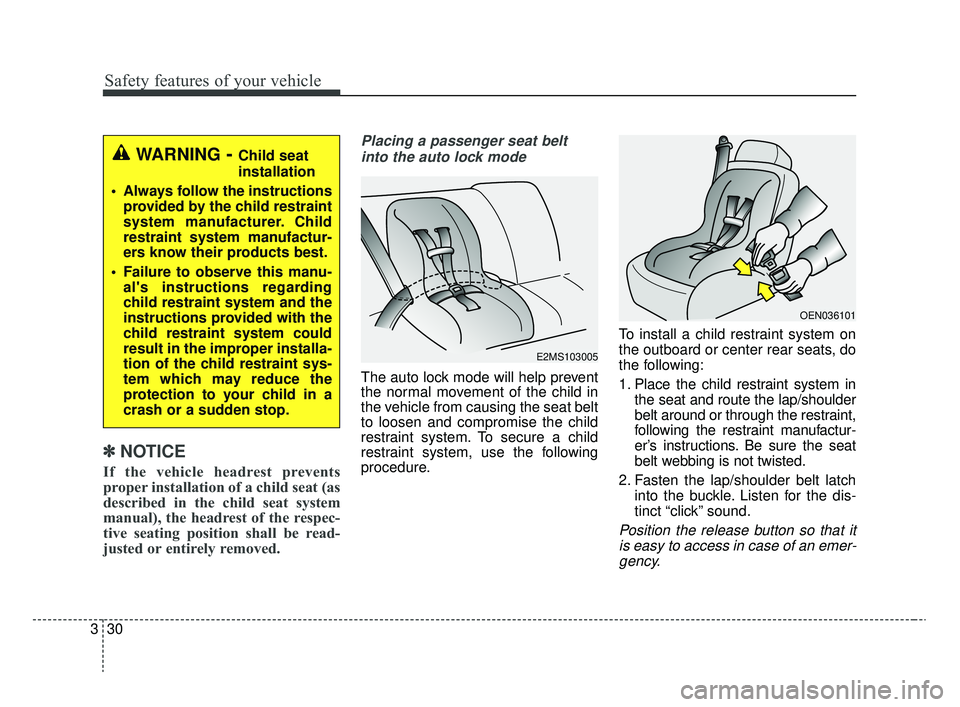
Safety features of your vehicle
30
3
✽ ✽
NOTICE
If the vehicle headrest prevents
proper installation of a child seat (as
described in the child seat system
manual), the headrest of the respec-
tive seating position shall be read-
justed or entirely removed.
Placing a passenger seat belt
into the auto lock mode
The auto lock mode will help prevent
the normal movement of the child in
the vehicle from causing the seat belt
to loosen and compromise the child
restraint system. To secure a child
restraint system, use the following
procedure. To install a child restraint system on
the outboard or center rear seats, do
the following:
1. Place the child restraint system in
the seat and route the lap/shoulder
belt around or through the restraint,
following the restraint manufactur-
er’s instructions. Be sure the seat
belt webbing is not twisted.
2. Fasten the lap/shoulder belt latch into the buckle. Listen for the dis-
tinct “click” sound.
Position the release button so that itis easy to access in case of an emer-gency.
WARNING- Child seat
installation
Always follow the instructions provided by the child restraint
system manufacturer. Child
restraint system manufactur-
ers know their products best.
Failure to observe this manu- al's instructions regarding
child restraint system and the
instructions provided with the
child restraint system could
result in the improper installa-
tion of the child restraint sys-
tem which may reduce the
protection to your child in a
crash or a sudden stop.
E2MS103005
OEN036101
SC CAN (ENG) 3.QXP 6/7/2019 9:38 AM Page 30
Page 50 of 516
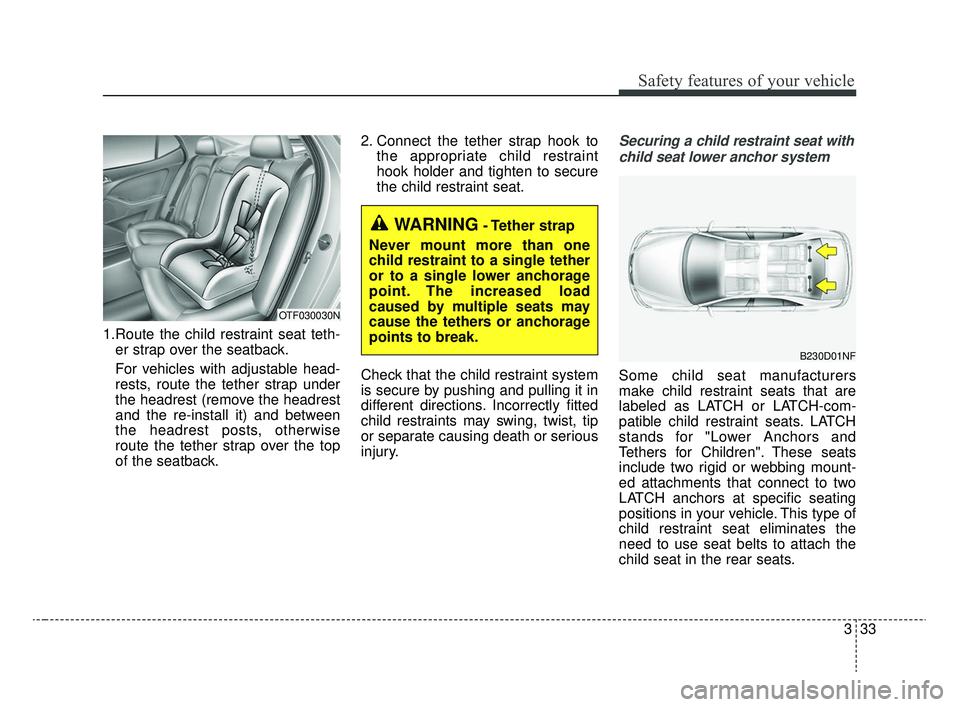
333
Safety features of your vehicle
1.Route the child restraint seat teth-er strap over the seatback.
For vehicles with adjustable head-
rests, route the tether strap under
the headrest (remove the headrest
and the re-install it) and between
the headrest posts, otherwise
route the tether strap over the top
of the seatback. 2. Connect the tether strap hook to
the appropriate child restraint
hook holder and tighten to secure
the child restraint seat.
Check that the child restraint system
is secure by pushing and pulling it in
different directions. Incorrectly fitted
child restraints may swing, twist, tip
or separate causing death or serious
injury.
Securing a child restraint seat with child seat lower anchor system
Some child seat manufacturers
make child restraint seats that are
labeled as LATCH or LATCH-com-
patible child restraint seats. LATCH
stands for "Lower Anchors and
Tethers for Children". These seats
include two rigid or webbing mount-
ed attachments that connect to two
LATCH anchors at specific seating
positions in your vehicle. This type of
child restraint seat eliminates the
need to use seat belts to attach the
child seat in the rear seats.
OTF030030N
WARNING- Tether strap
Never mount more than one
child restraint to a single tether
or to a single lower anchorage
point. The increased load
caused by multiple seats may
cause the tethers or anchorage
points to break.
B230D01NF
SC CAN (ENG) 3.QXP 6/7/2019 9:38 AM Page 33